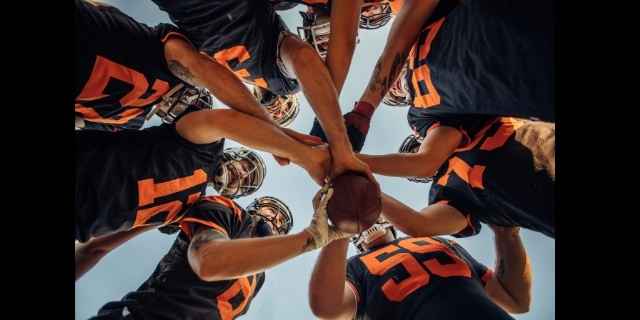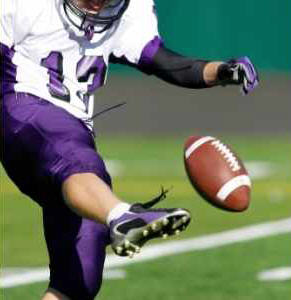Special teams are one of the unique features of American football. They are neither the offensive team nor the defensive team. They are only on the field for about twenty percent of the game.
However, they generate around thirty to thirty-five percent of the scoring.
Special team plays also have a huge impact on where the offense and defense start on the field for any given possession.
This article assumes you know nothing about this aspect of football. First, we’ll explain what special teams are. Then we’ll look at their history in the sport.
What Are Special Teams?
Special teams are any unit whose purpose involves the kicking game, whether for the team doing the kicking, the team returning the kick, or the team defending against the kick.
There are several special teams units on a football team:
- Punting teams
- Field goal teams
- Kickoff teams
We’ll break down each of these types in turn.

Punting Teams
When the offensive team has failed to make ten yards after three plays, they often opt to punt the ball away. This is to avoid taking the risk of handing over possession if they fail on the fourth try as well.
When the offense opts to punt, the offense sends out their punting team. In contrast, the defense sends out their punt return team.
The punting team’s first job is to protect the punter until he can punt the ball. They then race down the field either to tackle the ball carrier or to down the ball by touching it and stopping the play.
The punt receiving team’s first job is to try to block the punt. They aim to recover the ball behind the line of scrimmage.
If they can’t do that, they will fall back and set up blocking for the punt receiver.
The punting teams have several specialists. Let’s run through them.
The Punter
The punter’s job is to take the snap from center and punt the ball as far down the field as possible.

Of course, they don’t want the ball to go out of the back of the field. If that punt goes into or past the end zone, the receiving team gets to start on their 25-yard line.
The best punters are known as coffin-kickers. This refers to their ability to kick into the very back corner of the field and have the ball bounce out of bounds right before the end zone.
This leaves the other team starting backed up to their end zone and at high risk of giving up a safety.
The Long Snapper
Almost every football play starts when the center snaps the ball to another player. The long snapper is the special teams center.

Because both the punter and the kick holder are much farther back than the quarterback, the long snapper specializes in snapping the ball that distance.
Although he takes a fraction of the snaps that the starting center does, it’s almost always on a play that involves either a potential score or a major change of field possession.
Because of that, he must be flawless when called upon.
Good long snappers are highly sought after. They have can have some of the longest careers of any position, special teams or otherwise.
Gunners and Aces
Gunners are the faster player on the punting team. Their job is to line up on the outside and immediately sprint down the field and be the first person to the ball.
Their goal is to either down the ball by touching it, tackle the receiver, or force him to call for a fair catch, stopping the play.
Former USA Rugby Sevens player Nate Ebner is also an all-pro gunner. He first played for the New England Patriots and now for the New York Giants.
Ebner is also a co-owner of the New England Free Jacks (a professional rugby franchise in the MLR).
Jammer
The Jammer’s job is to get in the way of the gunner and stop him from getting down the field.
Returner
The returner is a specialist in catching the kick.
He also decides whether to down the ball by kneeling or to try and run with it.
Field Goal Units
The field goal teams come out when one team attempts to score by kicking the ball through the goalposts. This can be either for a three-point field goal or a one-point extra point after a touchdown.
The offensive field goal unit’s job is to protect the kicker while he makes the kick. The defensive unit’s job is to disrupt it.
The same long snapper from the punt team also snaps the ball on these plays. However, he is not the only specialist in this unit.
Placekicker

Unlike the punter who drops the ball on his foot, the placekicker kicks a stationary ball that’s either resting on a tee or being held by a holder.
The kicker and the punter are virtually never the same player, as they are such different skills.
Holder
The holder kneels behind the long snapper. His job is to:
- catch the snap
- put the ball nose down on the ground with his finger holding the top point
- spin the ball so the laces are away from the kicker
- put it at the angle the kicker prefers
This must happen within the seconds before the defense breaks through his line and comes roaring in to block the kick. He holds the ball in that position while the kicker makes his kick.
The punter is often also the holder.
The Kickoff Teams
Every half starts with a kickoff. The scoring team also kicks off after every touchdown and field goal
A kickoff also happens after a safety (when a team infringes within their own end zone). The team in possession must kick off to the opposing team.
In this scenario, the punter kicks the ball instead of the placekicker.
Normally, the placekicker is out there, as are the gunners. For the receiving team, the jammers are there as is the returner.
The long snapper does not take the field for this play.
History Of Special Teams In Football
In early American football, there were no special teams. This was because a player who left the field was out for the game.
This is now known as one-platoon football.
War of substitutions
With the scarcity of players during World War II, substitution rules were relaxed.
Two-platoon football came into its earliest form, with offensive and defensive specialists.
In 1954, one-platoon football was made mandatory. A long and bitter war over substitutions ensued.
This was finally resolved with unlimited substitutions being allowed in 1964. That was the beginning of special teams.
Earliest special teams
At first, there weren’t dedicated special teams players. Special teams were viewed as a place to get backups some playing time while reducing the risk to starters.
No coach would waste a valuable roster spot for a specialist just for kicking plays. There certainly were no special teams coaches.
Combining placekicking with other positions
Lou “The Toe” Groza was one famous kicker of the early era. He was both the placekicker and a starting offensive tackle for most of his career.
He became one of the first full-time kickers only when a back injury meant he could no longer play tackle.
George Blanda was the Raider’s quarterback and placekicker. Danny White was both the quarterback and punter for the Cowboys.
Early in his career, it was common to see Joe Thiesemann catch a kickoff and run it back. When he was tackled, he’d sprint to the sideline and pull off his running back shoulder pads. He’d don quarterback shoulder pads, and run back out and play quarterback!
Advent of full-time kickers
In the late 1960s, teams began to have full-time kickers. Among the first were Pete Gogolak and Garo Yepremian.
For a while, the stereotypical NFL kicker was a (comparatively) tiny little person who spoke almost no English.
This was because the teams were hiring soccer players to kick – and no one in the US played soccer in those days!
Start of the long snappers
Long snappers came next, in the mid-1980s. But this was something that not many fans noticed because most people don’t pay attention to offensive line substitutions.
Before the eighties, the starting center did every snap on every play. No center in the NFL does that now. Every team has a specialist long snapper.
Enter the star gunners
Where the changes in prestige for special teams really came about was with the advent of the star gunners.
The earliest of these were Steve Tasker(a former college rugby player) of the Buffalo Bills and Bill Bates of the Dallas Cowboys.
Both started playing in the 1980s. They electrified the crowds with their fearlessness, blazing speed, and hard hits.
Bates was the first special team specialist named All-Pro.
Evolution Of Strategy

At the same time, coaches began to focus on using field position as a big part of their game strategy.
Since nothing has a bigger effect on field position than special teams, they became correspondingly more important.
This trend has continued until every NFL team has a special teams coach and a full slate of specialists.
Interestingly, at a recent press conference, a reporter asked New England Patriots head coach Bill Belichick why they bothered using a roster spot on a long snapper.
The normally taciturn Belichick responded with a fascinating, nearly ten-minute lecture on the history of special teams.
From the mid-1960s until today, special teams have gone from almost an afterthought to a vital component of game strategy.
Now, it has gotten to the point where it can no longer even be accurately called two-platoon football. The modern game is three-platoon: offense, defense, and special teams.
More About The History Of Football
Check out our article that looks at the origins and early history of American football.
If you’re interested in early tactics that are now outlawed in the sport, check out our article on the flying wedge in American football.
If you’re interested in gear, check these out: